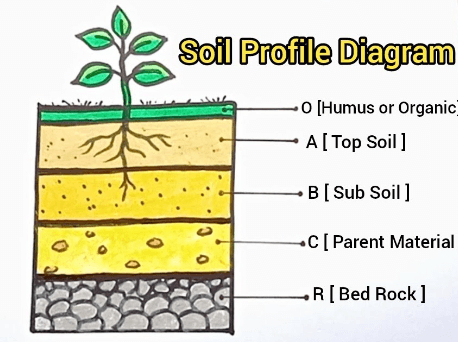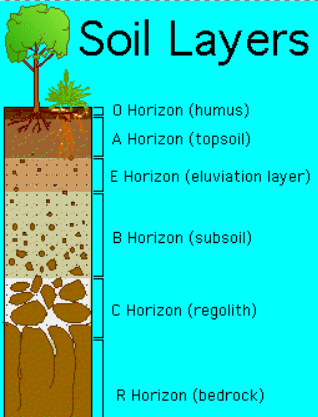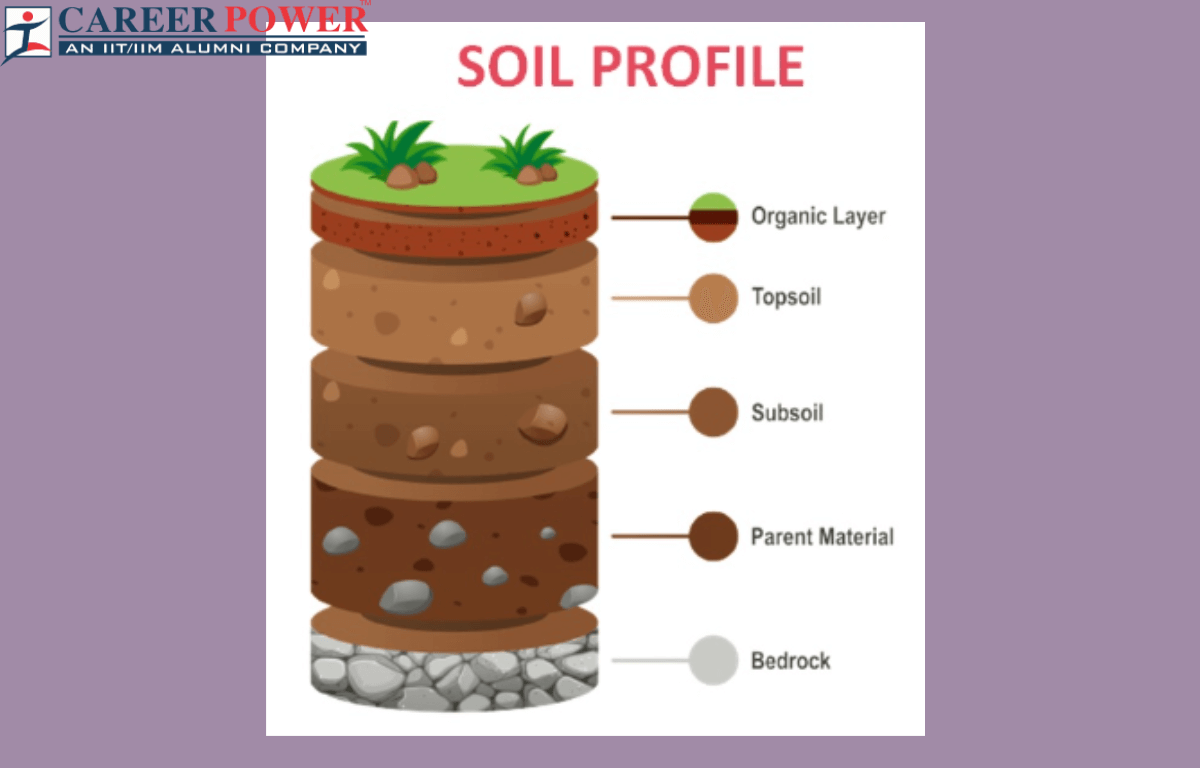As we know Soil is the dirt or ground beneath our feet, it is also considered a well-known topic in Biology. The soil acts as a reservoir for nutrients and supports various ecosystems. It comes in various types like sandy soil, clay soil, and loamy soil. Different plants grow better in different types of soil. Soil is essential for plants to grow and provide them with nutrients and support. It’s like a home for plants, helping them stay healthy and strong. Here we have briefly described the Soil, soil profile, soil profile diagram, and layers of soil below in the article.
What is Soil?
Soil is a natural resource that forms the Earth’s surface layer through the interaction of organic matter, minerals, water, air, and living organisms. It provides a medium for plants to grow, supports various ecosystems, and plays a crucial role in the Earth’s biogeochemical cycles. Soil composition varies, but typically includes minerals, organic matter, water, and air. Different types of soil have varying levels of fertility, influencing their ability to sustain plant and animal life.

Now, let us discuss some more about soil:
- Soil Horizons: Soils are often organized into layers or horizons. The top layer, known as the topsoil, is rich in organic matter and is where most plant roots grow. Below this, there are subsoil layers that contain minerals leached down from the above layer.
- Soil Types: Fertile soil contains a balance of essential nutrients like nitrogen, phosphorus, potassium, and micronutrients. Plants rely on these nutrients for growth. Soil fertility can be natural or enhanced through agricultural practices like fertilization and crop rotation.
- Soil Erosion and Conservation: Soil erosion occurs when wind, water, or human activity removes the topsoil. This process can lead to land degradation. Conservation methods like contour plowing, cover cropping, and terracing are used to prevent erosion and maintain soil health.
- Soil and Ecosystem: Soil is vital for various ecosystems, supporting plant life and, consequently, a diverse range of animals. Healthy soil promotes biodiversity and contributes to ecosystem services like water filtration and carbon storage.
What is a Soil Profile?
A soil profile is a vertical cross-section of the soil that displays all of its horizons (layers) from the surface down to the bedrock. It provides a detailed view of the soil’s composition, structure, and other properties at a specific location. Soil profiles are typically studied by soil fertility, drainage capabilities, and suitability for various agricultural or construction purposes.
Soil profiles help scientists and farmers comprehend the soil’s characteristics, including its texture, color, nutrient content, and depth of the different layers. By analyzing the soil profile, experts can make informed decisions about land use, crop selection, irrigation practices, and soil management techniques.
Soil Profile Diagram
A soil profile diagram is a visual representation of the layers (horizons) of soil from the surface down to the bedrock. In the soil profile diagram that we mentioned below, there is a brief description of almost all the layers of the soil such as Topsoil (A Horizon), Subsoil (B Horizon), Parent Material (C Horizon), and Bedrock. These layers are depicted vertically, showing their relative thickness and characteristics. Soil profile diagrams are essential tools for understanding the composition and quality of soil in a specific area, aiding in agricultural, ecological, and engineering assessments.

Components of Soil
Soil is a complex system with several important components and functions. Understanding soil composition and health is essential for sustainable agriculture, environmental conservation, and overall ecosystem well-being.
| Different Components of Soil | |
| Components | Description |
| Minerals | Weathered rock particles, including sand, silt, and clay. |
| Organic Matter | Decomposed plant and animal material, enriching soil fertility. |
| Water | Provides moisture for plants; soil acts as a water reservoir. |
| Air | Space between soil particles allows for gas exchange (oxygen, etc.) |
- Minerals: Soil is made up of mineral particles derived from weathered rocks. These particles include sand, silt, and clay, and their proportions determine the soil’s texture.
- Organic Matter: Dead plants and animal material decompose in the soil, forming organic matter. This organic matter provides nutrients to plants and enhances soil structure.
- Water: Soil acts as a reservoir for water, crucial for plant growth. Different soils have varying water-retaining capacities.
- Air: Spaces between soil particles allow for the exchange of gases between the soil and the atmosphere. Plants and soil organisms require oxygen for respiration.
Layers of Soil
Soil is typically composed of several layers, known as soil horizons. Each layer has its unique characteristics, and the composition can vary widely depending on factors like climate, vegetation, and geological processes. The main layers are:
| Different Layers of Soil | |
| Soil Layers | Description |
| O Horizon | It is the topmost layer of the soil, rich in organic material. |
| A Horizon | The A horizon is also known as topsoil, which is rich in minerals and organic material. |
| E Horizon | Leached layer, light in color and nutrient-poor. |
| B Horizon | Subsoil accumulates minerals and nutrients. |
| C Horizon | Partially disintegrated rock lacks organic material. |
| Bedrock | The solid rock beneath the soil layers. |

- O Horizon: This is the topmost layer of the soil, composed mainly of organic material like decomposed leaves and plant matter.
- A Horizon (Topsoil): This layer is rich in minerals and organic material. It’s where most plant’s roots grow and where many biological and chemical activities occur. The germination of seeds takes place in the Topsoil.
- E Horizon: This layer is light in color and leached of minerals and nutrients. It’s often found in forest ecosystems.
- B Horizon (Subsoil): This layer accumulates minerals and nutrients leached down from the topsoil. It contains minerals like iron, aluminum, and clay.
- C Horizon: This layer consists of partially disintegrated and weathered rocks. It lacks the organic material found in the upper layers.
- Bedrock: This is the solid rock beneath the soil layers. Roots do not penetrate this layer, and it is not considered part of the soil profile in terms of plant growth.
Importance of Soil
Soil is that part of an ecosystem, which is very essential for growing plants. Understanding and preserving soil health is crucial for sustainable agriculture, environmental conservation, and ensuring the well-being of ecosystems and human societies. Soil is incredibly important for various reasons:
- Agriculture: Soil provides essential nutrients and support for plants. Healthy soil is crucial for crop growth, which in turn sustains human and animal populations.
- Biodiversity: Soil is a habitat for many organisms, from insects to microorganisms. It supports biodiversity by providing food and shelter for various species.
- Water Filtration: Soil acts as a natural filter, purifying water as it percolates through the ground. It helps maintain the quality of groundwater resources.
- Carbon Storage: Soil stores a significant amount of carbon, playing a vital role in mitigating climate change by preventing carbon from entering the atmosphere as CO2.
- Construction: Certain types of soil, when properly compacted and stabilized, can be used as building materials. Soil is the foundation for many structures.
- Waste Decomposition: Soil helps in the decomposition of organic waste. It breaks down organic matter into simpler substances, recycling nutrients back into the ecosystem.
- Erosion Control: Vegetation rooted in soil prevents erosion by stabilizing the land. Healthy soil structure can absorb and retain water, reducing the risk of floods.
- Cultural and Recreational Uses: Soil supports parks, gardens, and recreational areas. It provides the foundation for landscaping and gardening activities.
- Medicinal Resources: Soil is a source of various minerals and compounds used in medicines and pharmaceuticals.
Important Questions for Soil Profile
Here we have discussed a few common questions regarding the Soil Profile along with their answers:
Q1. Define Soil.
Ans: Soil is the loose upper layer of the Earth where plants grow. It is made up of tiny rock pieces, minerals, water, air, and remains of dead plants and animals. Soil provides nutrients and support to plants. It also helps in holding water and air, which are needed in plant growth.
Q2. What are the Different Types of Soils?
Ans: There are mainly five types of soil, each with different features:
- Sandy Soil – Light and dry, has large particles. Water drains quickly. Not good for all plants.
- Clayey Soil – Heavy and sticky, holds water well. Good for crops like rice.
- Loamy Soil – A mix of sand, clay, and silt. Rich in nutrients. Best for farming.
- Silty Soil – Smooth and soft, holds water better than sandy soil. Good for plants.
- Peaty Soil – Dark, rich in organic matter. Holds water well, used in gardening.
Q3. Define Soil Profile.
Ans: A soil profile is like a slice of cake showing different layers of soil. These layers, called horizons, are stacked one over the other, and each has its own color and texture. The top layer has plants and roots, the middle has minerals, and the bottom is hard rock. By studying the soil profile, we learn how soil forms and supports life on Earth.



 50 Vegetables Name for Kids in English a...
50 Vegetables Name for Kids in English a...
 Food Chain: Definition, Types, Examples,...
Food Chain: Definition, Types, Examples,...
 Human Respiratory System: Definition, Di...
Human Respiratory System: Definition, Di...













